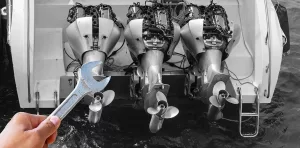 Aluminum Boat Repair
Aluminum Boat Repair
Aluminum Boat Repair. Boats, in general, require a lot of maintenance, especially aluminum boats in seawater. The salt content causes damage and excessive wear and tear. If you are experienced in the nuances, you can do most of the repairs yourself. However, the metal is quite strong and also lightweight.
These boats are easy to hook onto a boat trailer and also launch. Furthermore, they are affordable and less costly to handle. However, they do require a bit of care.
This article takes you through everything you need to know about aluminum boat repair by covering the following main topics:
- How Do You Repair Aluminum Boats?
- Can You Repair a Hole in an Aluminum Boat?
- How Do You Repair Cracks in the Hull?
- How Do You Repair a Leaking Seam or Rivet in an Aluminum Boat?
- What Do You Use to Seal the Bottom of an Aluminum Boat?
- Conclusion
How Do You Repair Aluminum Boats?
The most common problems you see in aluminum boats include:
- Pitting
- Cracks
- Crevice corrosion
- Leaky rivets
- Abrupt groundings
- Collision
Other than that, it may also develop small leaks due to general wear and tear. However, boat repair isn’t as tricky. With the right products, aka brazen rods, repairs are a quick and easy task.
Bring the Boats onto Land
Remove the boat from the water and bring it onto the land if possible to a covered area. Place three sawhorses in a triangular shape on a flat surface. Lift the boat and balance it on its sides. Position it such that the hole or the scratch is upwards facing you. Clean the area with acetone and rags. Ensure that you remove the water, algae, and mud stains. Considering that you are using chemicals, wear a mask and gloves for protection.
Lift the Dents
If you had been in a collision, you could find inward dents in the metal. You can lift the dents yourself with the help of an anvil and hammer. Get a friend to hold the anvil as a backstop while you wield a hammer and pound the dent out. Straighten and tap out to flatten the body. Here, you are stretching the metal to imitate its natural shape. Remember that rubber mallets work better for more minor dents. Use a metal hammer only when you have more impact.
Determine the Size of the Hole or Crack
The first step to repairing a crack is to measure it. Next, use aluminum strips to create a container for the brazen rod to settle in. Finally, apply adhesive to the tips and affix it to the base.
Repair the Holes and Cracks
Create a v-shaped channel with a drill motor and a grinding cone. For a puncture, use a cone bit to grind the area. This is done to create more area for the brazen weld. Next, sand the area with 220-grit sandpaper and ensure that it overlaps on every side.
Use a wire brush to scrape the area. Crosshatch strokes will ensure that you have an uneven area on the surface. Finally, use consistent heat from a heat source such as a propane torch to fix the brazen rods on the sides. You can also use a tig welder to weld aluminum sheets onto the crack.
Can You Repair a Hole in an Aluminum Boat?
Yes! You can repair holes in an aluminum boat. The best way to mend a hole is to weld it at a welding shop. However, you also have the option of using epoxy. The latter is rising in popularity due to its ease of operation and availability in repair kits.
How Do You Repair a Hole in Aluminum Boats with Epoxy?
There’s been a time when a hole in your boat warrants a trip to the welding shop — or discarding the boat. But you can repair aluminum boats with epoxy with ease, restoring them to their original quality. All you need is an aluminum boat repair kit. It should contain all the tools you need for a boat repair.
- Restore the hull to its original shape by hammering the torn metal. The edges should lie flat, even if it means cutting away the torn edges. Soften the edges and create a solid bonding area using 120-grit sandpaper. Furthermore, remove paint with a coarse bristle disc both inside and outside.
- Cut patches from Episize™ glass fabric for both sides. Allow for overlap around the hole for a proper bond. Brush both sides with the epoxy and let it sit for half-hour. Back brush any rundowns. Ensure that you work it into the dings and scratches.
- Lay the patches on plastic and wet them with the resin. Apply the patches over the outside of the hole with overlap at the edges. Smooth it over such that there is no air trapped inside. Leave it overnight to cure.
- The following day, remove the roughness from the patches by grinding them. Finally, apply a mixture of the resin and a low-density filler.
- Once fully cured, the boat is now ready for the waters.
How Do You Repair Cracks in the Hull?
While aluminum boats are corrosion resistant, the alloy doesn’t work well in seawater and causes hull damage. Apart from that, the collision can also cause cracks. However, you can repair the cracks by yourself with a brazing rod and a heat source.
Heat the aluminum using a propane torch. It should be hot enough such that it melts the brazen rods. The melted metals should form a bond and not sit over the surface. Ensure that the heat is consistent, else you may end up damaging the boat.
How Do You Repair a Leaking Seam or Rivet in an Aluminum Boat?
Every aluminum boat has leaks either from a rivet or a seam after years in the water. While some may be a little seep, others may straight on be a stream of water. Whatever it is, you can use an aluminum boat repair kit for a fair and easy job. The product we use here is G/flex by West System.
Here’s how you repair leaks in aluminum boats:
- The first and foremost step is to identify all the leaks. First, fill the boat on the inside up with water right up to the waterline. It’s best to leave the boat leaning either fore or aft so you’re not filling the entire boat with water, which could end up causing more damage.
- Next, get underneath the boat to look for leaks at both seams and rivets, and once identified, circle them with a magic marker. It is better to flip the boat for easier access.
- Prepare the area around the leaks for bonding. For leaks in seams, remove any debris that may still be stuck there. On the rivets, use a wire brush in a circular motion for the resin to bond.
- Apply a good solvent wipe to the surface to remove any contaminants that might be left before bonding.
- Prepare the G/flex mixture in the ratio of 1:1 (viscosity of honey).
- Doing one rivet at a time, use a propane torch (or similar heat source) to dry off the surface and force out any water.
- Finally, apply G/flex with a 12cc syringe to the heated surface. Use a heat gun to both get it to flow out and get it to stay in any position you might be working overhead so it will cure a little faster and gel up so you can move onto the next one without drips.
- If you have fully cured all the leaks with the heat gun, you can take the boat into the water in as little as an hour; else you may want to let it cure on its own for at least 12 hours.
What Do You Use to Seal the Bottom of an Aluminum Boat?
If the bottom of your boat is bare aluminum, it pays to have it sealed with a high-quality epoxy primer. An aluminum boat sealer helps to protect the surface from regular wear and tear, leaking rivets, seams, and cracks. As a result, you can avoid expensive repairs in the long run.
First and foremost, you’d want a sealant that is formulated especially for aluminum. It should adhere to the metal and form a strong bond. It should also not corrode the metal and ensure that your boat is well protected.
Finally, it should be able to withstand harsh environmental conditions and chemicals. Above all, it should be waterproof. That way, it provides a complete seal.
Aluminum Boat Leak Sealer
Using a high-quality sealant is crucial since it can increase the life of your boat. Of the hundreds of products available in the market, the following are some of the best out there.
- G/flex 650 by West System
- TotalBoat Aluminum Boat Leak Sealer
- Woody Wax Metal Sealer
Conclusion
 Aluminum boats are somewhat inexpensive when compared to other boats like fiberglass. They are also sturdy and easy to use. However, on the flip side, they are also labor-intensive. As long as you care for your boat, you can wrangle a lifetime of about 30 – 40 years.
Aluminum boats are somewhat inexpensive when compared to other boats like fiberglass. They are also sturdy and easy to use. However, on the flip side, they are also labor-intensive. As long as you care for your boat, you can wrangle a lifetime of about 30 – 40 years.
Any minor leaks, cracks, and holes can be repaired at home using a boat repair kit. Or, if you are handy, you can also use a propane torch to weld brazen rods. When using an aluminum boat repair kit, ensure that you follow the instructions to the letter. Not every product is the same, especially when working with sealants or epoxy.
When to get expert help
While any novice can repair a boat, it is not safe to fix any large holes. And any repairs related to the boat engine, engine housing, or fuel tank should be performed by a boat repair shop or a licensed marine mechanic. Since 2004, Cutting Edge is committed to delivering quality service, quick turnarounds, and the best customer service in the Tucson area. If you or someone you know is in need of having their boat repaired or restored, contact us for your free quote today!
Other related articles you may enjoy:
